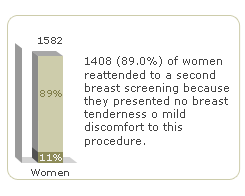34 MENOPAUSE SYMPTOMS |
HEALTH CENTER |
|
LEARN MORE |
|||||||||||||||||||||||||||||||||||||||||||||||
| Menopause | |||||||||||||||||||||||||||||||||||||||||||||||
| Symptoms | |||||||||||||||||||||||||||||||||||||||||||||||
| Herbs for Menopause | |||||||||||||||||||||||||||||||||||||||||||||||
|
|||||||||||||||||||||||||||||||||||||||||||||||
|
|||||||||||||||||||||||||||||||||||||||||||||||
|
|
Prevalence of Breast Tenderness during Mammography |
A panel of specialists from the Department of Radiology at the Dana-Farber Cancer Institute in Boston carried out a study to find out if women who attend to breast cancer screenings felt some degree of breast tenderness or any type of pain. This study was led by Dr. Stomper, who reviewed the records from a several questionnaires and a survey earlier performed. |
|
The women who were tested completed a 43-question telephone survey within 3 weeks after the mammography was done. The investigators try to assess the independent predictors of breast soreness at mammography as controlling for all other factors. After the breast screening, patients quantified pain using a six-point scale. Discomfort was qualitatively evaluated by multivariate analysis. Subjects aged 45-64 years from seven health centers were invited to attend for a second breast cancer examination at a mobile clinic. A poll about their experience of the previous screening was completed by 641 women who attended and 124 who did not attend the second test. |
 |
Twenty six per cent of the women had found the former test painful, and a minority also reported embarrassment (7%) or distress (6%).Women who did not through a second examination were significantly more likely than those who did to report the former screening test as embarrassing or distressing and were considerably less likely to have found the clinic examiners helpful or attendance for screening worthwhile or reassuring Of the 1582 women who were examined, 1408 (89.0%) reattended. These women felt no breast tenderness or just had mild pain, so they considered a mammogram again. The grade of discomfort was lightly greater in women who complained of breast tenderness within three days prior to the mammogram but was not openly related to age, menstrual status, or week of the menstrual cycle. Women rated their experience on a six-point level ranging from no discomfort to intense pain. Eighty-eight percent of the women felt no discomfort (49%) or mild discomfort (39%). Only 9% experienced moderate discomfort; 1%, intense discomfort; and 1%, moderate pain. In other words, the breast tenderness was not strong enough to interrupt a second test. The investigation showed that a minority of women agreed with the statement that the test had produced breast tenderness. In terms of overall reactions to the experience, most women considered the breast cancer screening was worthwhile. By Natural-Progesterone-Estrogen-Supplements.com
Sources: STOMPER, P. C. et al .Is mammography painful? A multicenter patient survey. |
|
| Back to Home: | 34 Menopause Symptoms |  |
